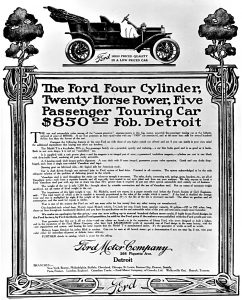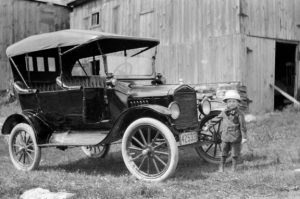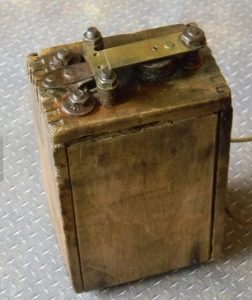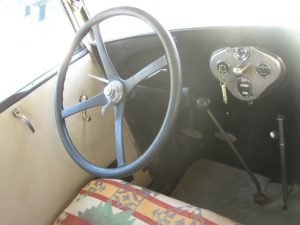In 1908 Henry Ford brought to market his brain child – the Model T Ford Automobile. It sold for $850. By 1925 he had increased the efficiency of his factory using the assembly line, interchangeable parts, and other techniques. He could now sell this car for $260 and still make a profit. This translates to about $3500 in today’s money, and it was now affordable for most people in America. By 1927 when the Model T was superseded by the Model A, 15 million had been sold, and over half the cars in the US were Model T Fords. This was the longest run of any automobile model in history until 1972, when the Volkswagen Beetle surpassed it.

Henry Ford’s Ad for the Model T

Model T Ford Sedan (notice that the kid has his hand on the crank)
Unlike later automobiles whose transmissions were a series of sliding gears, the Model T ’s transmission consisted of a series of bands and clutches similar to the modern automatic transmission. It had 2 speeds forward and one reverse. There were 3 pedals on the floor- the right pedal was the brake, the middle pedal reverse. The left pedal had 3 positions – down was low gear, half-way up was neutral, and all the way up was high gear. This pedal could also be controlled by a lever on the left side of the driver.

Model T Floorboard
The accelerator was a lever on the right side of the steering column. the lever on the left side was called the “spark” and adjusted the timing. The high voltage needed for the spark plugs was generated by a magneto and induction coil. The car was started with a crank. Later models had a battery and electric starter. The windshield wiper was hand-operated. The gas tank was under the driver’s seat in most models. There was no fuel pump so gas was gravity-fed to the engine. The transverse spring suspension was similar to that of a horse-drawn buggy, and like a buggy, the spokes in the wheels were made of hickory wood.
The models manufactured between 1914 and 1925 were all painted black. This was the only paint that would dry fast enough to keep up with the rate that cars were being manufactured, which in 1926 was between 9000 and 10000 cars per day!
Along with the car came some tools – including a monkey wrench, pliers, and screw driver. Most problems that occurred on the road could be solved with these tools.

Ford Monkey Wrench
In some cities headlights were forbidden at night because they would scare the horses. Instead, lanterns were hung on the car so it could be seen.

Model T with Lanterns (up by windshield)
The car would sometimes “backfire” while being cranked causing the crank to fly around, and often a broken thumb or broken arm would result. Special instructions were provided that showed how to hold the crank to avoid injury.(See the link at the bottom of this page)
When climbing a steep hill the Model T was often turned around to climb the hill backwards. This was done for 2 reasons:
1. Reverse was the lowest gear.
2. Since the fuel was gravity-fed, this was necessary on long hills in order to keep the fuel running into the engine.
In the ‘30s it was not unusual to see a Model T slowly backing up Sand Hill on Hartville Road in Randolph, Ohio.
Top speed was said to be 40 mph, but due to the quick steering and unstable suspension, only a fool with a death wish would drive at that speed.
The advantages of the automobile over the horse were obvious:
1. The car was much faster, averaging 25 to 30 miles per hour. A horse would average about 12-15 mph.
2. You could leave a car for weeks or months without feeding it. A horse will die without constant maintenance.
3. Cars don’t poop. You don’t have to follow a car with a shovel to clean the road.
The horse had one advantage over the car in that it knew how to get home without assistance. The driver could go to sleep in his buggy after a night of partying and the horse would always take him back to the barn. With the advent of self-driving cars, this advantage may soon go away.
All in all, the Model-T was a marvel of efficiency and simplicity, and changed forever the way people live in the civilized world.
When I was a kid the Model T was getting somewhat rare and the Model A was taking its place as America’s favorite auto. However, I do have a few recollections of these marvelous machines.
As a high school student I worked on a produce farm in Hartville, Ohio. The owner had an old Model T with the body replaced by a wooden platform. It was once used to haul radishes and other produce from the field to the wash house. It still ran but the steering wheel was missing. There was a square shaft sticking out of the steering column where the missing steering wheel should be. During lunch break we had a great time driving this thing around the farm steering it with a monkey wrench! Because of its skinny tires it made tracks through the muddy fields that looked like two bicycles has passed through.
Having possession of a Model T spark coil was a dream come true for an ornery kid. With this and a 6-volt dry cell one could produce an electric shock strong enough to make a nun cuss. One of our favorite tricks was to hook this combination up to a door knob.

Model T Spark Coil
My brother-in-law Paul was a fan of old machinery. He acquired a Model T and drove it to work. This car had the unusual characteristic of backfiring with an ear-splitting blast exactly 10 seconds after the engine was shut down. It was fun watching Paul arriving home from work and trying to get inside his house before the explosion assaulted his ear drums.
Art Fayler was a bachelor-recluse who lived in Randolph. He was a quiet man and rarely talked to anyone. He was dark and sinister-looking, and the kids in town were afraid of him. He drove the last Model T in Randolph that I remember – and drove it slowly and carefully. When he died Donnie Franks bought Mr. Fayler’s house along with the Model T which was in pristine condition. Donnie painted the car bright yellow and raced recklessly around town blowing the “oogah” horn. I often wonder whether cars have a memory and if that one wondered what had happened to cause this violent change.
Model T “Oogah” Horn
My father told me about a trip his family took in 1920. They drove 2 Model T Fords from West Virginia to Kissimmee, Florida to visit his Uncle Emmett.
Emmett and his family were cowboys and raised Brahma cattle. Nobody had yet heard of Disney or Snow White, and Kissimmee looked more like a Texas cattle town than today’s tourist destination. The road to Florida was often single lane mud with wheel ruts. Dad told of putting horse manure in the car’s radiator to stop it from leaking. I once saw a photo of the Model Ts loaded up for this trip. It reminded me of the Oakies heading for California in “Grapes of Wrath”.
The Model A Ford superseded the Model T in 1927. It was more stable and had controls much like today’s stick shift car.
When I was about 7 years old my uncle Claude Lang had an old Model A Ford panel truck. There was no passenger’s seat so a pop case was substituted. When Claude gave me a ride he would “pop the clutch”and I would fall backwards off of the pop case. He thought that was quite hilarious.
Me, not so much.
In 1942 Dad bought a Model A Ford Coupe for $90. It was quite cramped for a family of 4 during the winter because the weather was too cold to use the “rumble seat”. I rode between Mom and Dad and my sister had to ride on Mom’s lap. It was a real treat to ride in the rumble seat in warm weather.

Model A Ford coupe with the rumble seat open
The front window of the Model A was safety glass but the rear window was plate glass. One day I was hitting a golf ball with a baseball bat. On one big swing I knocked the ball right through the plate glass rear window of our Model A coupe. Glass flew everywhere. Dad was watching and I thought for sure I was going to catch some real grief. I must have looked mighty scared because Dad started laughing and said, “Boy, you were really going for distance that time!”.

The Model A windshield was safety glass…

…but the rear window was plate glass

Model A Interior
During WWII, tanks and planes were being made instead of automobiles, and most of the cars I remember seeing on the road were Model A Fords. The war ended in 1945, and in 1946 cars were again being manufactured.
After 4 years of driving the Model A coupe, Dad sold it for $250 and bought a 1946 Chevrolet sedan.
Bob wrote:
Gene,
I remember my Grandpa’s “Model A”. He lived on the Madina road in the mountains just north of Ravenswood WVa. This was around 1948-1953.
His Model A had an air conditioner! It consisted of one small fan that was mounted on the right side of the dash. It had a rubber blade that had no guard to protect young inquisitive fingers from being hit. I know because I remember learning a very painful lesson when my cousins and I played in that car. The fan was pointed directly at the driver and actually made a comfortable breeze.
Gene replied:
As you probably know, those fans were mainly used as windshield defroster-defoggers on those cars.
They worked OK for fog but not too well for heavy frost. For air conditioning they just rolled down the windows 🙂
I recall an incident with one of those rubber-bladed fans that occurred when I was a kid during WWII. My Aunt Jane (whom I wrote about previously) was being courted by a soldier who had just returned from the front in Europe. I was sitting in a Model A with them (I’m sure they were overjoyed with my presence!) that had one of those rubber bladed defroster fans. The fan was running and I was causing it to speed up and slow down by letting the blades rub a pencil I was holding. It made a whirring sound like a siren. The soldier immediately got the shakes and started to fall apart. He told me to stop because the whirring noise reminded him of the sound a Stuka dive bomber made when the plane went into its bombing run. The Nazis put sirens on those planes which turned them into terror weapons. The screaming noise terrified the people on the ground.
It took a few minutes for the soldier to calm down.
We call it PTSD now, then it was called “combat fatigue”.
Bill wrote:
It always puzzled me why the “T” was superseded by the “A”! Seems to me that the “A” should have come first.
Gene replied:
According to what I found:
It was a natural progression starting with the first Model A in 1903. There was then the B, C, F, K, N, R & S. The missing letters were experimental or never got off the drawing board.
The Model T was Ford’s first automobile mass-produced on moving assembly lines with completely interchangeable parts, marketed to the middle class.
The Model A followed. The company publicity said this was because the new car was such a departure from the old that Henry wanted to start all over again with the letter A.
There, now you can sleep again 🙂